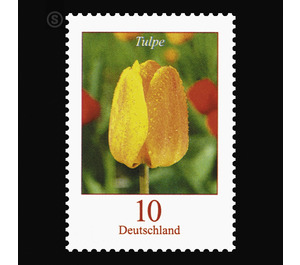Postal stamps: flowers - Germany / Federal Republic of Germany 2005 - 10 Euro Cent
Theme: Flora
| Country | Germany / Federal Republic of Germany |
| Issue Date | 2005 |
| Face Value | 10.00 |
| Perforation | S 14 |
| Stamp Type | Postage stamp |
| Item Type | Stamp |
| Chronological Issue Number | 2357 |
| Chronological Chapter | GER-BRD |
| SID | 657154 |
| In 92 Wishlists | |
Whether yellow, purple, pink or violet, whether striped or spotted - the colorful splendor of the tulips is today the decoration of many flowerbeds. The tulip belongs to the family of the lily family and originates from Central Asia. There are about 100 species of wild animals from which thousands of varieties have been bred. The "wild tulip" (Tulipa silvestris) is found mainly in the south of Central Europe. Flowering hangs before flowering, which distinguishes it from the cultivated garden tulip (Tulipa gesneriana). This is always characterized by an upright flowering. In Germany, the tulip was first mentioned in 1559 in Augsburg. It is said to have got its name because it resembles the traditional, wrapped headdress of the Ottomans, the turban, which in Turkish is called "dulbend".


